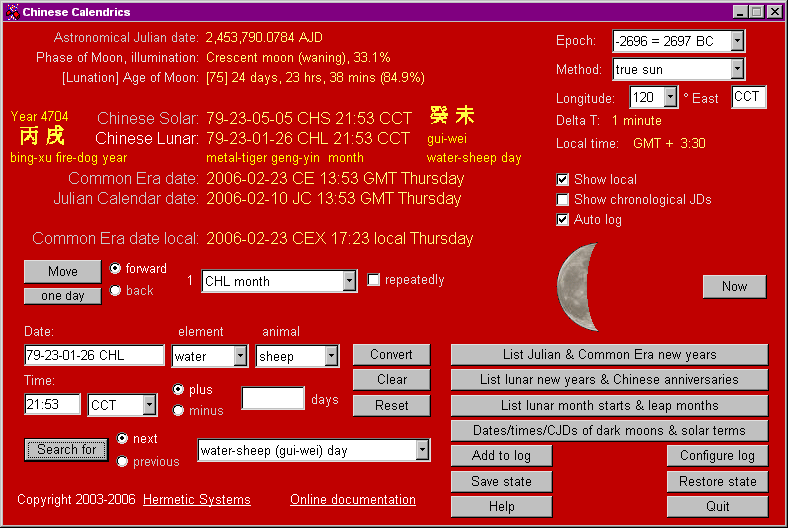Chinese Calendrics Screenshot

The Chinese Lunar Calendar is a solilunar calendar, consisting of months corresponding exactly to lunar cycles and years which stay more-or-less in sync with seasonal years. The structure of the calendar depends on the exact times of certain astronomical events, principally dark moons and winter solstices.
The solar calendar consists of a series of seasonal years which are divided into 24 "solar terms". The lunar calendar consists of a series of years which are divided into 12 or 13 lunar months. A solar year always begins at the (northern) winter solstice. A lunar month always begins on the day of a dark moon.
Chinese Calendrics is used to do the following:
To convert between dates in the Chinese solar and lunar calendars and dates in the Common Era and Julian calendars.
To calculate the date of New Year's Day in the Chinese lunar calendar.
To ascertain the Western dates of the starts of all lunar months in a year in the lunar calendar.
To find leap months in the lunar calendar.
To find the Western dates corresponding to Chinese anniversaries (e.g., birthdays).
To move forward or backward from a given date (and time) either by a period such as a month (Western or Chinese) or by any number of days.
To calculate the phase of the Moon for any time within a 6000-year period.
To search for the next or previous full moon, dark moon, lunar quarter, solar term or solstice or equinox of a certain type.
To search for a solstice or an equinox in combination with a dark moon or a full moon.
To search for the next or previous day, month or year with a certain element-animal correspondence (e.g., the next water-rabbit year or the next fire-chicken day).
To find days for which the element-animal is the same for day, month and year.
Back to Chinese Calendrics Details page
- Chinese Calendrics Software
- English Chinese Chinese Dictionary Pdf
- Chinese Name
- Chinese Plus
- Chinese IP
- Chinese Com
- Chinese Course
- Chinese To Chinese
- Chinese Prc For Pc
- Ocr Chinese Os X
